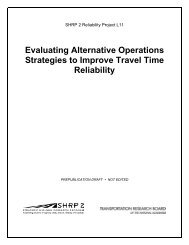Annotated Bibliography - SSTI
Annotated Bibliography - SSTI
Annotated Bibliography - SSTI
Create successful ePaper yourself
Turn your PDF publications into a flip-book with our unique Google optimized e-Paper software.
Title<br />
Traffic Generated by Mixed‐Use Developments—Six‐Region Study Using Consistent Built<br />
Environmental Measures<br />
Authors<br />
Reid Ewing, Michael Greenwald, Ming Zhang, Jerry Walters, Mark Feldman, Robert<br />
Cervero, Lawrence Frank, and John Thomas<br />
Sponsor Reconnecting America<br />
Date December, 2009<br />
Pages 21<br />
Category Development, Modes: All<br />
Note New method for calculating traffic from mixed use development.<br />
Online<br />
Summary<br />
http://www.reconnectingamerica.org/assets/Uploads/trafficmixedusedevelopments20<br />
09.pdf<br />
This study develops a new methodology for predicting traffic impacts in mixed used<br />
developments as contrasted with the standard method recommended by ITE. The ITE<br />
method is based on experience at 6 multiuse sites in Florida. The researchers chose<br />
mixed use developments (MXD) in 6 regions that had high quality data available that<br />
met these two criteria:<br />
• regional household travel surveys with XY coordinates for trip ends, so we could<br />
distinguish trips to, from, and within small MXDs; and<br />
• land use databases at the parcel level with detailed land use classifications, so landuse<br />
intensity and mix could be observed down to the parcel level.<br />
The authors found only 13 regions that met the first criterion and only six regions:<br />
Houston, Boston, Atlanta, Portland, Sacramento, and Seattle that met both. These six<br />
provided for a research base of 239 MXDs. The internal capture, non‐auto rate for all<br />
trips averaged 29%, with the external walk and transit shares varying considerably<br />
among MXDs and the cities. Boston had the highest average external (from<br />
development) walk rate at 13.2%, with Seattle having the highest external transit rate<br />
at 8.7%, as shown below:<br />
Walk Transit<br />
Atlanta 3.2% 2.1%<br />
Boston 13.2% 3.7%<br />
Houston 2.7% 5.2%<br />
Portland 7.1% 3.3%<br />
Sacramento 1.8% 0.2%<br />
Seattle 4.7% 8.7%<br />
External auto trip distances among the regions also varied substantially, with the<br />
average distances among all of 7.5 miles. The range was from 4.8 miles for MXDs in<br />
Boston to 13.6 miles for MXDs in Houston.<br />
The analysis shows that mixed‐use developments reduce traffic impacts compared to<br />
conventional development – 3 out of 10 trips produced or attracted to an MXD pose no<br />
burden to the street/roadway system. They also generate walking and transit trips, and<br />
shorten vehicle trips.<br />
<strong>Annotated</strong> <strong>Bibliography</strong> Page 14















